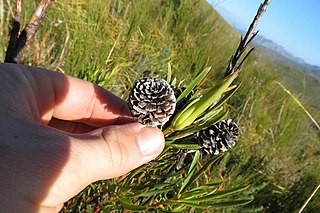
Leucadendron coniferum, also known at the dune conebush, is an evergreen, dioecious shrub or small tree of up to 4 m (13 ft) high, that has been assigned to the family Proteaceae. It has a whorl of conspicuous yellow leaves subtending the flowerheads. The flowers can be found in August and September. It grows in sandy soils near the coast of the Western Cape province of South Africa.

Leucadendron linifolium, the line-leaf conebush, is a flower-bearing shrub that belongs to the genus Leucadendron and forms part of the fynbos. The plant is native to the Western Cape, South Africa.
Leucadendron burchellii, the Riviersonderend conebush, is a flower-bearing shrub that belongs to the genus Leucadendron and forms part of the fynbos. The plant is native to the Western Cape, South Africa.

Leucadendron dregei, the summit conebush, is a flower-bearing shrub belonging to the genus Leucadendron and forms part of the fynbos. The plant is native to the Western Cape, South Africa.

Leucadendron rourkei, the Uniondale conebush, is a flower-bearing shrub belonging to the genus Leucadendron and forms part of the fynbos. The plant is native to the Western Cape and Eastern Cape, South Africa. The plant is rare.

Leucadendron procerum, the ivory conebush, is a flower-bearing shrub that belongs to the genus Leucadendron and forms part of the fynbos. The plant is native to the Western Cape, South Africa.

Leucadendron salicifolium, the common stream conebush, is a flower-bearing shrub belonging to the genus Leucadendron and forms part of the fynbos. The plant is native to the Western Cape where it occurs from Porterville to Kogelberg and Langeberg.

Leucadendron teretifolium, the needle-leaf conebush, is a flower-bearing shrub belonging to the genus Leucadendron and forms part of the fynbos. The plant is native to the Western Cape, South Africa.

Leucadendron spissifolium subsp. fragrans, the fragrant spear-leaf conebush, is a flower-bearing shrub belonging to the genus Leucadendron. The plant is native to the Western Cape and occurs in the Langeberg and Outeniqua Mountains from Gysmanshoek to the Woodville Forest Reserve, as well as the Swartberg and Kammanassie Mountains. It forms part of the fynbos.
Leucadendron osbornei, the Laingsburg conebush, is a flower-bearing shrub belonging to the genus Leucadendron and forms part of the fynbos. The plant was discovered by David Osborne and is native to the Western Cape, South Africa.

Leucadendron spissifolium subsp. phillipsii, the Kareedouwvlakte spear-leaf conebush, is a flower-bearing shrub belonging to the genus Leucadendron and forms part of the fynbos. The plant is native to the Eastern Cape and Western Cape, South Africa.
Leucadendron sericeum, the Wabooms conebush, is a flower-bearing shrub belonging to the genus Leucadendron and forms part of the fynbos. The plant is native to the Western Cape, South Africa.

Leucadendron pubibracteolatum, the purple-leaf conebush, is a flower-bearing shrub belonging to the genus Leucadendron and forms part of the fynbos. The plant is native to the Western Cape and Eastern Cape.

Leucadendron platyspermum, the plate-seed conebush, is a flower-bearing shrub belonging to the genus Leucadendron. It form part of the fynbos biome. The plant is native to the Western Cape, where it occurs from the Donkerhoekberg near Villiersdorp, Groenlandberg, and Kleinmondberge from Houhoek to the Elimvlakte.

Leucadendron meridianum, the limestone conebush, is a flower-bearing shrub belonging to the genus Leucadendron and forms part of the fynbos. The plant is native to the Western Cape, South Africa.
Leucadendron sheilae, the Lokenberg conebush, is a flower-bearing shrub that belongs to the genus Leucadendron and forms part of the fynbos, a South African biogeographical region. The plant is native to the Western and Northern Capes, where it occurs at Lokenberg in the Bokkeveld Mountains. The plant grows mainly in hard sandstone sand on level crests at altitudes of 600 to 900 metres (2,000–3,000 ft). In Afrikaans it is known as Lokenberg-tolbos.
Leucadendron gydoense, the Gydo conebush, is a flower-bearing shrub that belongs to the genus Leucadendron and forms part of the fynbos. The plant is native to the Western Cape, South Africa.

Leucadendron elimense, the Elim conebush, is a flower-bearing shrub, which belongs to the genus Leucadendron and forms part of the fynbos. The plant is native to the Western Cape, South Africa.

Leucadendron modestum, the rough-leaf conebush, is a flower-bearing shrub that belongs to the genus Leucadendron and forms part of the fynbos. The plant is native to the Western Cape, South Africa.
Leucadendron muirii, the silver-ball conebush, is a flower-bearing shrub that belongs to the genus Leucadendron and forms part of the fynbos. The plant is native to the Western Cape, where it is found on the Elim, Bredasdorp and Riversdale plains. The shrub grows to 2.0 m in height and bears flowers from November to December.














